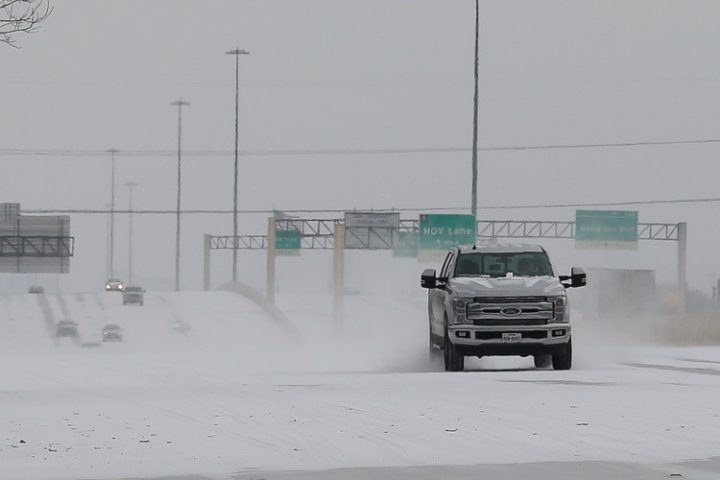
As temperatures across America’s heartland plummeted over the last several days, prices spiked to unprecedented levels for natural gas and electricity and shortages of the latter led to widespread blackouts across Texas.
In the northern Great Lakes on Monday morning, temperatures plunged to the negative 20s and even negative 30s below zero. Notably, because this was not an unusual occurrence in the winter for this region, life continued as normal and the power stayed on.
This has not been the case in Texas, where temperatures reached as low as 9º Fahrenheit in San Antonio and 18º Fahrenheit in Houston on Monday, February 15. The next day, temperatures in the Dallas area remained in the upper single digits and low teens. The National Weather Service has continued a Winter Storm Warning for the region:
...WINTER STORM WARNING IN EFFECT UNTIL 8 PM CST THIS EVENING... * WHAT...Heavy mixed precipitation is ongoing. Significant ice and sleet accumulation continue to be possible over Central and East Texas this morning. Total ice accumulations between 1/10 and 1/4 of an inch are possible east of I-35 and south of I-20 with isolated amounts to 1/2 inch. Total snow accumulations of 2 to 4 inches are possible along the Red River with widespread 1 to 2 inches possible elsewhere. * WHERE...Portions of North and Central Texas. Significant ice accumulation is expected over Central Texas. Significant snow accumulation is expected over eastern portions of North Texas. * WHEN...Until 8 PM CST this evening. * IMPACTS...Travel could become dangerous. Additional power outages and tree damage are likely due to the ice.
The freezing weather has played havoc with the Texas electric grid, sending prices soaring and causing blackouts around the state as new “green” energy windmills froze in place, undermining the state’s power-generation capacity.
Among the states, Texas has been a nationwide leader in wind-power generation. In 2019, CNN reported that wind power in the state was generating more energy than coal for the first time. “Wind has generated 22% of the state’s electrical needs this year,” CNN reported at the time. “It just edged out coal, which provided 21% of the Lone Star State’s power, according to the Electrical Reliability Council of Texas.”
Perhaps more startling is just how quickly wind power grew to surpass coal. In 2003, less than one percent of the state’s power came from wind, while coal generation accounted for 40 percent, according to CNN.
As everything is bigger in Texas, as the saying goes, so is wind power. The state produces more wind-generated electricity than most countries. “Remarkably, at more than 27 gigawatts (GW) of generation, Texas has become the world’s fifth biggest generator of wind power, beaten by only four countries,” the World Economic Forum said in praise of Texas wind in January 2020.
But in February 2021, the state’s reliance on the vagaries of wind is putting citizens at risk. Currently, the winds of Texas produce enough electricity to power more than seven million homes — when conditions allow the turbines to spin.
Now, frozen by a deep blast of Arctic air, about half of those wind turbines are offline.
“Nearly half of Texas’ installed wind power generation capacity has been offline because of frozen wind turbines in West Texas, according to Texas grid operators,” the Austin American Statesman reported.
Also offline is natural gas production. “The extreme cold that we’ve seen in Texas, in the Midcontinent, has wreaked havoc and not only do you have a situation where demand for natural gas is extremely high, production has been shut in because the pipelines are frozen,” said Phil Flynn, a senior analyst at Price Futures Group in Chicago, according to Hart Energy.
High demand and low supply have caused the price of natural gas to spike. By February 15, the price had reached $500 per million British thermal units (mmBTUs). “The fuel normally trades in the region for less than $3 per mmBtu,” Bloomberg reported.
The constricted supply of natural gas, along with the curtailment of production from frozen wind power assets, contributed to a shortage of available grid electricity, and to a massive spike in the price of that electricity.
“Spot power prices in Texas hit the $9,000-per-megawatt-hour cap for a fourth straight day,” Bloomberg reported. “To prevent the collapse of their networks, suppliers from North Dakota to Texas are instituting rolling power cuts for the second consecutive day to limit demand.” For comparison, “Reminding readers,” Zerohedge reported, “ERCOT prices are usually around $25/MWh.”
The extreme energy shortage has led, more or less, to the collapse of the electricity grid in Texas and, as the cold streak continues, increasingly through the middle of the country, and even into Mexico as gas exports south of the border are curtailed as a result of shortages.
As of the morning of February 17, PowerOutage.US reported that nearly 3.4 million people in Texas were without power, a situation that has persisted for days on end. Other significant outages were reported in Oregon, Kentucky, Louisiana, and West Virginia. Reporting on the outages, Bloomberg called it “undoubtedly the largest forced blackout in U.S. history.” Underscoring the impact of the blackout, Bloomberg concluded, “Judging by the average size of a U.S. household, and the amount of load shed in Texas, at least 15 million people may have been plunged into darkness in that state alone.”
Needless to say, a power outage during an extreme cold outbreak can be deadly. In Houston of all places, normally known for its warm climate, Police Chief Art Acevedo reported the death a man found unresponsive by a passerby. Chief Acevedo noted the suspected cause of death is thought “to be related to exposure to extreme low temperatures.”
In Houston, those fortunate enough to have a wood stove or a fireplace were lining up for a chance to purchase firewood. “More than 50 vehicles” were lined up at one firewood business on the morning of February 16, according to the Houston Chronicle. The wait time to buy firewood from the business was up to an hour and a half, the paper noted.
The abrupt shortage of energy and the collapse of the grid in Texas highlights a significant challenge to the future plans to roll back traditional energy production in favor of the “Green New Deal’s” planned transition to primarily solar and wind power. That transition would result in a reduction of diversity in energy generation technologies. Reduced diversity results in increased systemic risk of failure. In energy generation, the opposite approach would be to rely on an increased diversity of fuels and generating technologies.
Currently, that diversity exists but is reduced from what it might be, as coal and natural gas are slated for reductions in favor of wind and solar, while nuclear technology, which offers massive scale with little to no safety or environmental externalities, has been stagnant for many years. In particular, it is likely that if Texas and other areas tied into the regional grid had access to more nuclear capacity, today’s blackouts would not have occurred. As it is, Texas has only two nuclear stations, and one was partially shut down due to the impact of the cold weather.
The Biden energy plan calls for a “Carbon Pollution-Free Power Sector by 2035.”
That, essentially, is a call for a massive reduction in diversity in the power-generating technologies that provide electricity to American homes and businesses. And that puts the U.S. power infrastructure at greater risk of systemic failure due to unforeseen shocks such as that which has hit the U.S. central states and Texas, especially, in recent days.
To see the future of the Biden “Build Back Better-Green New Deal” energy plan, look no further than the misery being experienced by millions of Texans this week.



